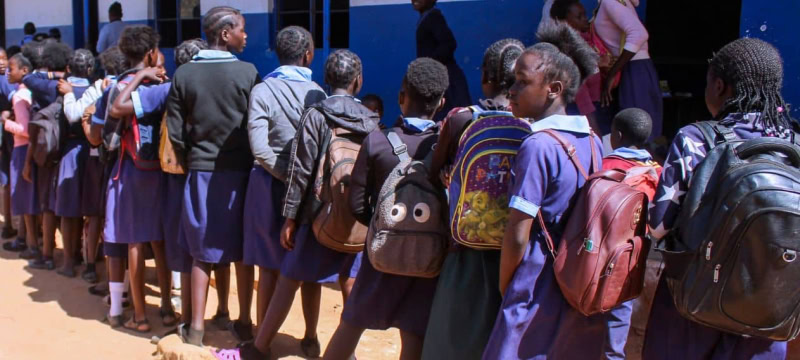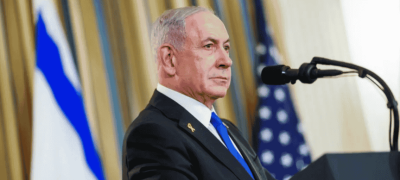It’s 7:00 AM on a chilly winter morning as a group of students arrives at Chanyanya Primary and Secondary School, located just over an hour’s drive from Lusaka, Zambia capital.
“Coming early is essential because there’s a shortage of desks,” says 16-year-old Richard Banda. “I arrived late two days ago and had to sit on the floor, which was really cold.”
This discomfort highlights the resource and overcrowding issues resulting from the government’s decision to provide free primary and secondary education. The school consists of ten classrooms arranged in a horseshoe shape around a playground filled with acacia trees and plants growing in sandy soil.
Read more: QAU to Provide Martyrs’ Children with Free Education and Scholarships
As the morning sun rises, dust is kicked up by students sweeping the classrooms. Just before the bell, one student runs to the playground’s center to raise the Zambian flag on a tall pole.
These morning rituals are now part of the daily routine for two million additional children who have been able to attend state schools without fees since the government made education free in 2021. However, experts warn that without sufficient infrastructure investment, overcrowding is jeopardizing the quality of education, particularly for low-income students.

“I stopped attending school in 2016 while in grade four,” says 18-year-old Mariana Chirwa, wearing Chanyanya’s light-blue uniform with a tartan bow. “Without free education, I don’t know how my parents could have sent me back; they don’t work and stay at home.”
A poster in the headteacher’s office highlights the challenges faced by schools like Chanyanya. One classroom holds 75 boys and 85 girls in a space meant for just 30 students.
“When I started in 2019, there were about 40 students, but now there are over 100 in one class,” says 33-year-old teacher Cleopatra Zulu.
“Every day, we get new students due to free education. It’s hard to have one-on-one interactions, and even grading is difficult. We’ve had to reduce the number of subjects we offer.”

Richard Banda’s experience highlights the issue. “We don’t learn the same way as before when we had to pay; there’s a noticeable difference,” he tells to reporters. “When there were fewer students, the teacher would explain a topic again if we didn’t understand, but now, with so many of us, they don’t repeat it.”
The increase in student numbers is seen across sub-Saharan Africa, with more children attending school than ever, according to UNICEF. However, nine out of ten primary school students in the region still struggle with reading and comprehension. As a result, policymakers are shifting their focus to improving education quality, hiring qualified teachers, and enhancing infrastructure and resources.
“When students can’t sit properly in class, it affects their attention and note-taking,” says Aaron Chansa, director of the National Action for Quality Education in Zambia (NAQEZ). “We see students entering secondary school unable to read adequately,” he adds, noting similar issues nationwide. In Eastern Province, over 100 students share one classroom, worsening the book-to-pupil ratio, with some sharing one book among six or seven learners.
The government acknowledges these challenges and is working to address them. “This is a good problem,” says Education Minister Douglas Syakalima. “I’d prefer children to be in crowded classrooms than on the streets. The president has initiated mass production of desks and is overseeing significant infrastructure development.”

Zambia has invested over $1 billion (£784 million) in education since implementing free schooling three years ago, reversing years of declining spending in the sector. The government plans to build more than 170 new schools and recruit 55,000 teachers by the end of 2026, with 37,000 already hired.
While this initiative has created job opportunities, it has also led to housing shortages in rural areas. Some teachers report living in grass-thatched houses and sharing pit latrines that risk overflowing. “During the rainy season, you really don’t want to visit us,” says Ms. Zulu, who lives on the school compound and recalls worrying about cholera during an outbreak earlier this year.
Outside her home, a patch of dried shower gel marks where a resident bathed openly, with only darkness for privacy. “The houses we live in are like death traps,” Ms. Zulu adds. “The government needs to address the housing situation, especially concerning toilets.”

Worried about their children’s learning outcomes, some families are taking action. Robert Mwape, a taxi driver in Lusaka, moved his 11-year-old son from a private school to a public one in 2022 to benefit from free education but soon regretted it. “I noticed his grades started to drop. When I visited the classroom, there were too many students, and the teacher struggled to maintain focus,” he said.
The following year, Mwape reversed his decision, and now his 13-year-old son is back in a private school. With Zambia gradually recovering from a debt default in 2020, some experts question the sustainability of the free education policy. A 2023 report from the Zambia Institute for Policy Analysis and Research warns that if all eligible students enroll, government spending could double, raising concerns about future government commitment to the policy.
However, Education Minister Douglas Syakalima remains confident in their ability to manage costs, stating, “Education is the best economic policy.” While making education free is seen as a vital step toward providing young Zambians with better opportunities, the country is facing challenges in maintaining educational quality amid rising student numbers.










